BLO1105 Business Law Assignment: Contractual Issues Examined
VerifiedAdded on 2022/08/26
|13
|3255
|16
Report
AI Summary
This assignment report analyzes a business law scenario involving a dry-cleaning service and a customer. Part A examines the formation of a contract between John and Span and Spic, addressing the elements of offer, acceptance, consideration, capacity, and intention. It applies legal principles from cases like Pharmaceutical Society of Great Britain v Boots and Brogden v Metropolitan Railway Co. Part B investigates the validity of an exclusion clause on the receipt, assessing whether it limits Span and Spic's liability for damaged goods. It explores the rules around exclusion clauses in signed and unsigned documents, considering tests like the 'nature of the document' and 'reasonable notice' tests, as well as the contra proferentem rule. The report concludes with a determination of the contract's validity and the enforceability of the exclusion clause, using relevant case law and legal principles to support its findings.

Running Head: 0
Business Law
BLO1105
1/15/2020
Student’s Name
Business Law
BLO1105
1/15/2020
Student’s Name
Paraphrase This Document
Need a fresh take? Get an instant paraphrase of this document with our AI Paraphraser
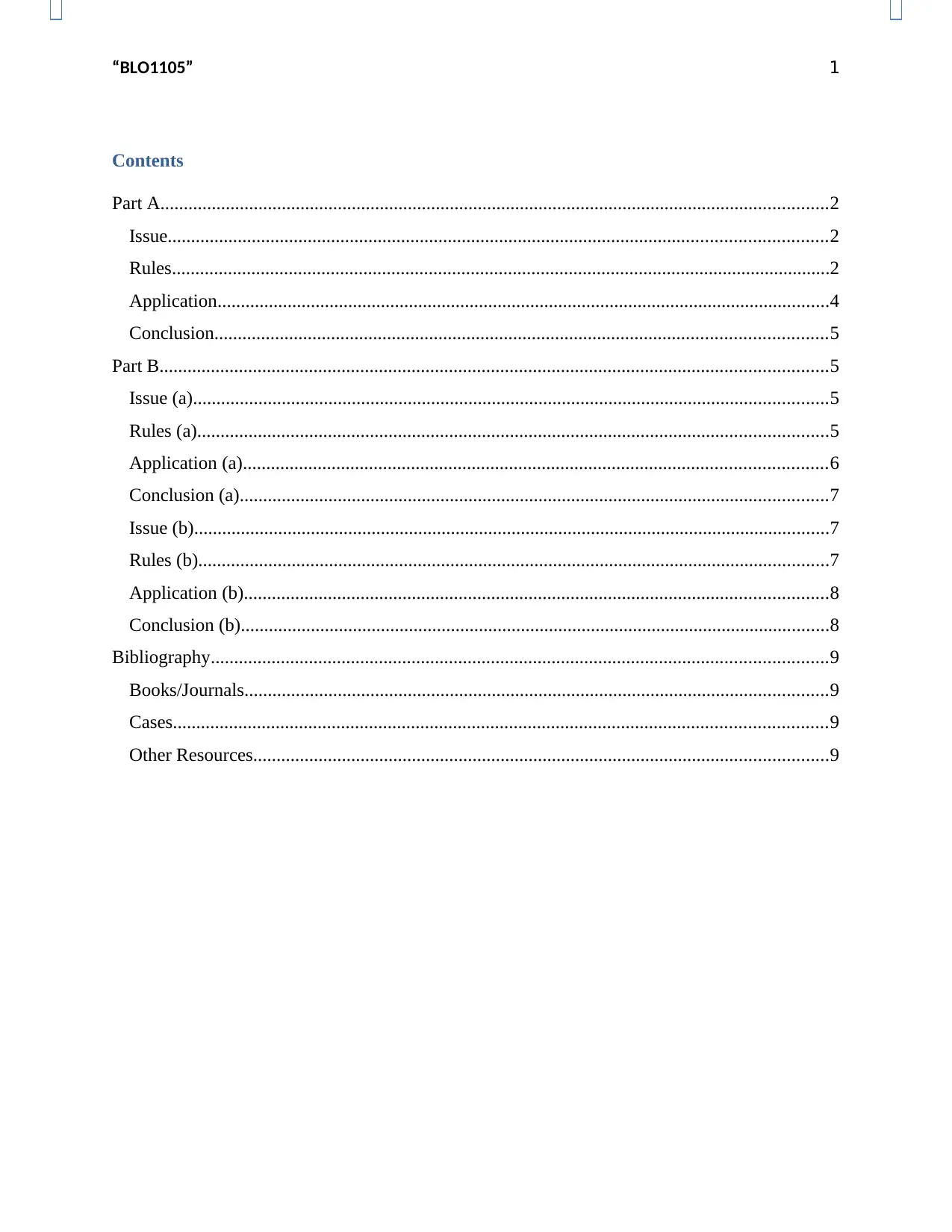
“BLO1105” 1
Contents
Part A...............................................................................................................................................2
Issue.............................................................................................................................................2
Rules.............................................................................................................................................2
Application...................................................................................................................................4
Conclusion...................................................................................................................................5
Part B...............................................................................................................................................5
Issue (a)........................................................................................................................................5
Rules (a).......................................................................................................................................5
Application (a).............................................................................................................................6
Conclusion (a)..............................................................................................................................7
Issue (b)........................................................................................................................................7
Rules (b).......................................................................................................................................7
Application (b).............................................................................................................................8
Conclusion (b)..............................................................................................................................8
Bibliography....................................................................................................................................9
Books/Journals.............................................................................................................................9
Cases............................................................................................................................................9
Other Resources...........................................................................................................................9
Contents
Part A...............................................................................................................................................2
Issue.............................................................................................................................................2
Rules.............................................................................................................................................2
Application...................................................................................................................................4
Conclusion...................................................................................................................................5
Part B...............................................................................................................................................5
Issue (a)........................................................................................................................................5
Rules (a).......................................................................................................................................5
Application (a).............................................................................................................................6
Conclusion (a)..............................................................................................................................7
Issue (b)........................................................................................................................................7
Rules (b).......................................................................................................................................7
Application (b).............................................................................................................................8
Conclusion (b)..............................................................................................................................8
Bibliography....................................................................................................................................9
Books/Journals.............................................................................................................................9
Cases............................................................................................................................................9
Other Resources...........................................................................................................................9
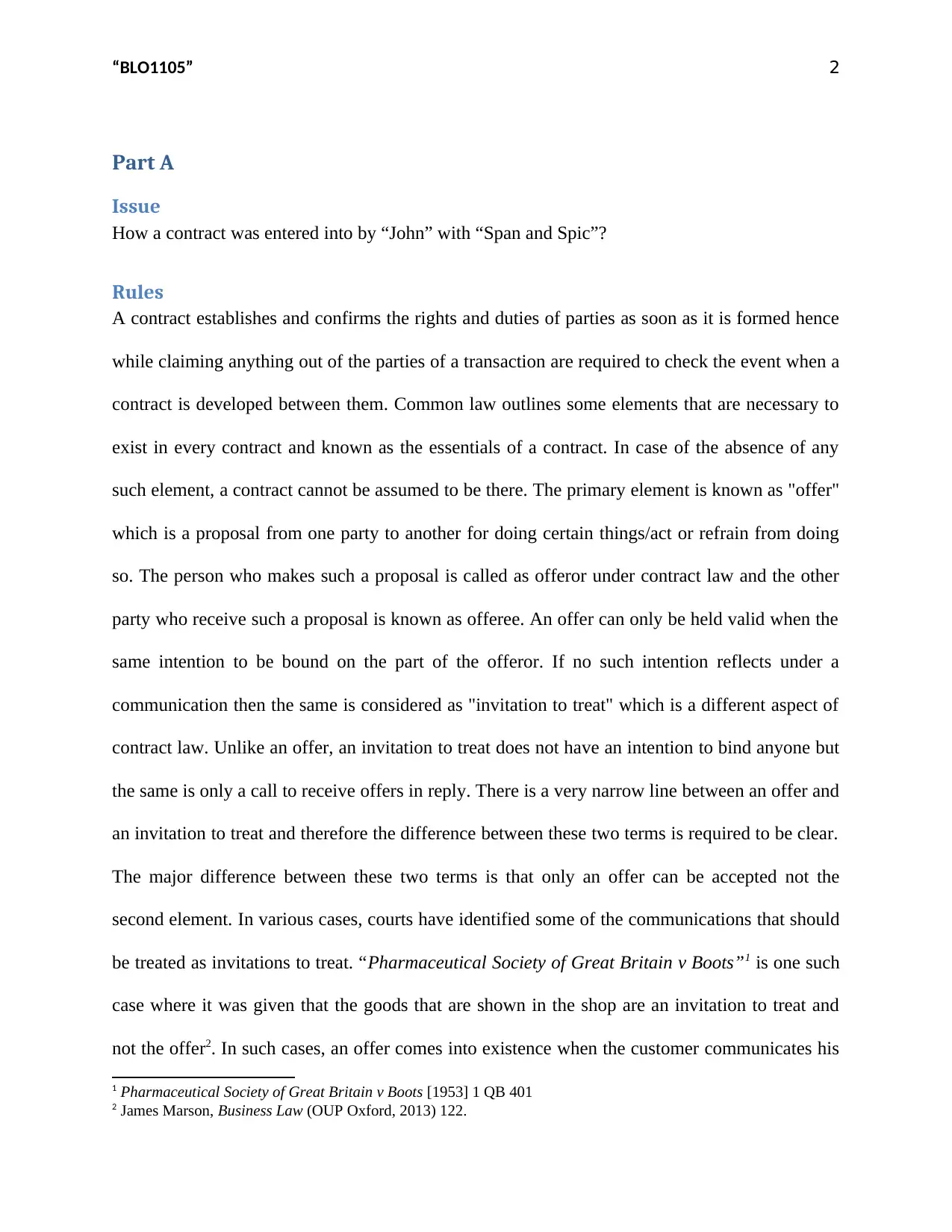
“BLO1105” 2
Part A
Issue
How a contract was entered into by “John” with “Span and Spic”?
Rules
A contract establishes and confirms the rights and duties of parties as soon as it is formed hence
while claiming anything out of the parties of a transaction are required to check the event when a
contract is developed between them. Common law outlines some elements that are necessary to
exist in every contract and known as the essentials of a contract. In case of the absence of any
such element, a contract cannot be assumed to be there. The primary element is known as "offer"
which is a proposal from one party to another for doing certain things/act or refrain from doing
so. The person who makes such a proposal is called as offeror under contract law and the other
party who receive such a proposal is known as offeree. An offer can only be held valid when the
same intention to be bound on the part of the offeror. If no such intention reflects under a
communication then the same is considered as "invitation to treat" which is a different aspect of
contract law. Unlike an offer, an invitation to treat does not have an intention to bind anyone but
the same is only a call to receive offers in reply. There is a very narrow line between an offer and
an invitation to treat and therefore the difference between these two terms is required to be clear.
The major difference between these two terms is that only an offer can be accepted not the
second element. In various cases, courts have identified some of the communications that should
be treated as invitations to treat. “Pharmaceutical Society of Great Britain v Boots”1 is one such
case where it was given that the goods that are shown in the shop are an invitation to treat and
not the offer2. In such cases, an offer comes into existence when the customer communicates his
1 Pharmaceutical Society of Great Britain v Boots [1953] 1 QB 401
2 James Marson, Business Law (OUP Oxford, 2013) 122.
Part A
Issue
How a contract was entered into by “John” with “Span and Spic”?
Rules
A contract establishes and confirms the rights and duties of parties as soon as it is formed hence
while claiming anything out of the parties of a transaction are required to check the event when a
contract is developed between them. Common law outlines some elements that are necessary to
exist in every contract and known as the essentials of a contract. In case of the absence of any
such element, a contract cannot be assumed to be there. The primary element is known as "offer"
which is a proposal from one party to another for doing certain things/act or refrain from doing
so. The person who makes such a proposal is called as offeror under contract law and the other
party who receive such a proposal is known as offeree. An offer can only be held valid when the
same intention to be bound on the part of the offeror. If no such intention reflects under a
communication then the same is considered as "invitation to treat" which is a different aspect of
contract law. Unlike an offer, an invitation to treat does not have an intention to bind anyone but
the same is only a call to receive offers in reply. There is a very narrow line between an offer and
an invitation to treat and therefore the difference between these two terms is required to be clear.
The major difference between these two terms is that only an offer can be accepted not the
second element. In various cases, courts have identified some of the communications that should
be treated as invitations to treat. “Pharmaceutical Society of Great Britain v Boots”1 is one such
case where it was given that the goods that are shown in the shop are an invitation to treat and
not the offer2. In such cases, an offer comes into existence when the customer communicates his
1 Pharmaceutical Society of Great Britain v Boots [1953] 1 QB 401
2 James Marson, Business Law (OUP Oxford, 2013) 122.
⊘ This is a preview!⊘
Do you want full access?
Subscribe today to unlock all pages.

Trusted by 1+ million students worldwide
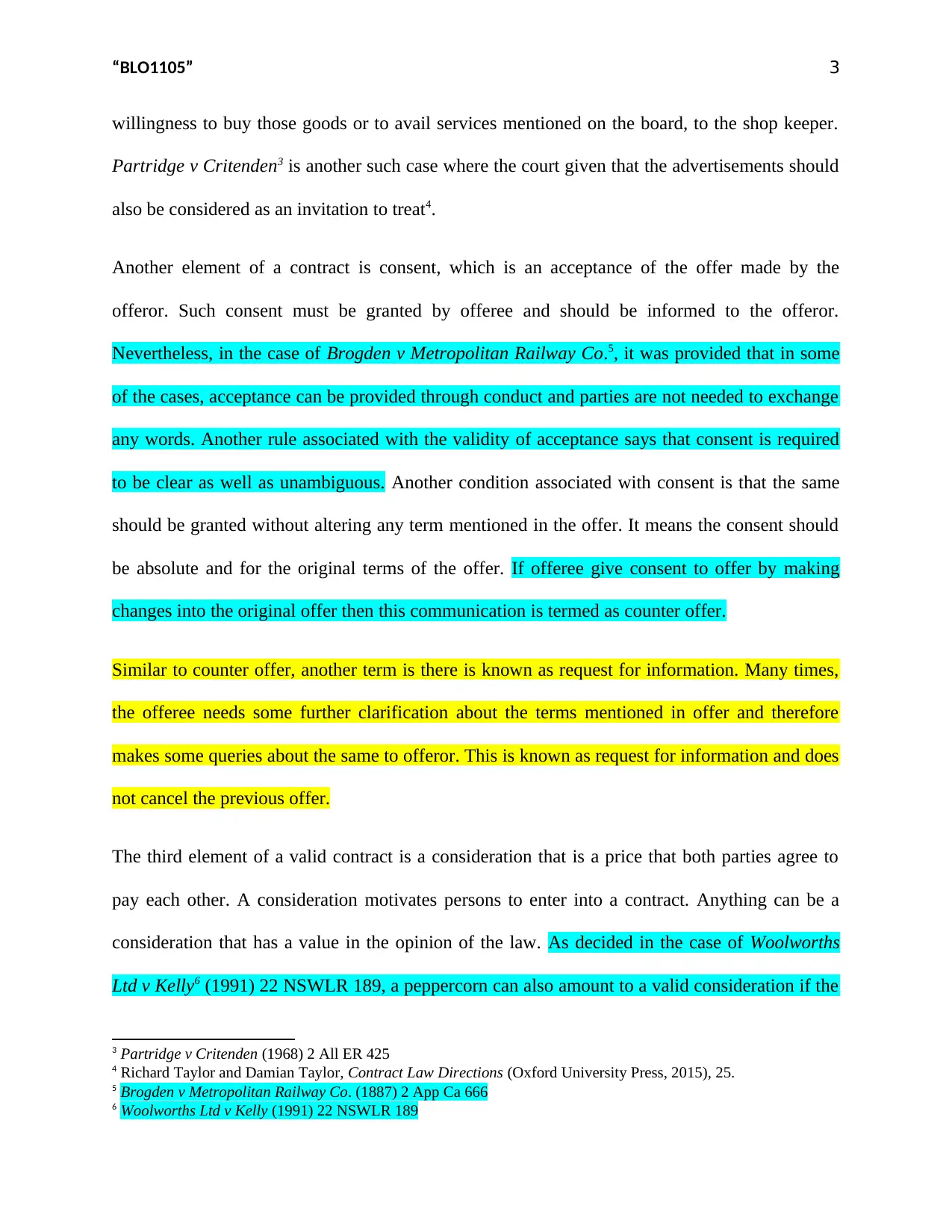
“BLO1105” 3
willingness to buy those goods or to avail services mentioned on the board, to the shop keeper.
Partridge v Critenden3 is another such case where the court given that the advertisements should
also be considered as an invitation to treat4.
Another element of a contract is consent, which is an acceptance of the offer made by the
offeror. Such consent must be granted by offeree and should be informed to the offeror.
Nevertheless, in the case of Brogden v Metropolitan Railway Co.5, it was provided that in some
of the cases, acceptance can be provided through conduct and parties are not needed to exchange
any words. Another rule associated with the validity of acceptance says that consent is required
to be clear as well as unambiguous. Another condition associated with consent is that the same
should be granted without altering any term mentioned in the offer. It means the consent should
be absolute and for the original terms of the offer. If offeree give consent to offer by making
changes into the original offer then this communication is termed as counter offer.
Similar to counter offer, another term is there is known as request for information. Many times,
the offeree needs some further clarification about the terms mentioned in offer and therefore
makes some queries about the same to offeror. This is known as request for information and does
not cancel the previous offer.
The third element of a valid contract is a consideration that is a price that both parties agree to
pay each other. A consideration motivates persons to enter into a contract. Anything can be a
consideration that has a value in the opinion of the law. As decided in the case of Woolworths
Ltd v Kelly6 (1991) 22 NSWLR 189, a peppercorn can also amount to a valid consideration if the
3 Partridge v Critenden (1968) 2 All ER 425
4 Richard Taylor and Damian Taylor, Contract Law Directions (Oxford University Press, 2015), 25.
5 Brogden v Metropolitan Railway Co. (1887) 2 App Ca 666
6 Woolworths Ltd v Kelly (1991) 22 NSWLR 189
willingness to buy those goods or to avail services mentioned on the board, to the shop keeper.
Partridge v Critenden3 is another such case where the court given that the advertisements should
also be considered as an invitation to treat4.
Another element of a contract is consent, which is an acceptance of the offer made by the
offeror. Such consent must be granted by offeree and should be informed to the offeror.
Nevertheless, in the case of Brogden v Metropolitan Railway Co.5, it was provided that in some
of the cases, acceptance can be provided through conduct and parties are not needed to exchange
any words. Another rule associated with the validity of acceptance says that consent is required
to be clear as well as unambiguous. Another condition associated with consent is that the same
should be granted without altering any term mentioned in the offer. It means the consent should
be absolute and for the original terms of the offer. If offeree give consent to offer by making
changes into the original offer then this communication is termed as counter offer.
Similar to counter offer, another term is there is known as request for information. Many times,
the offeree needs some further clarification about the terms mentioned in offer and therefore
makes some queries about the same to offeror. This is known as request for information and does
not cancel the previous offer.
The third element of a valid contract is a consideration that is a price that both parties agree to
pay each other. A consideration motivates persons to enter into a contract. Anything can be a
consideration that has a value in the opinion of the law. As decided in the case of Woolworths
Ltd v Kelly6 (1991) 22 NSWLR 189, a peppercorn can also amount to a valid consideration if the
3 Partridge v Critenden (1968) 2 All ER 425
4 Richard Taylor and Damian Taylor, Contract Law Directions (Oxford University Press, 2015), 25.
5 Brogden v Metropolitan Railway Co. (1887) 2 App Ca 666
6 Woolworths Ltd v Kelly (1991) 22 NSWLR 189
Paraphrase This Document
Need a fresh take? Get an instant paraphrase of this document with our AI Paraphraser
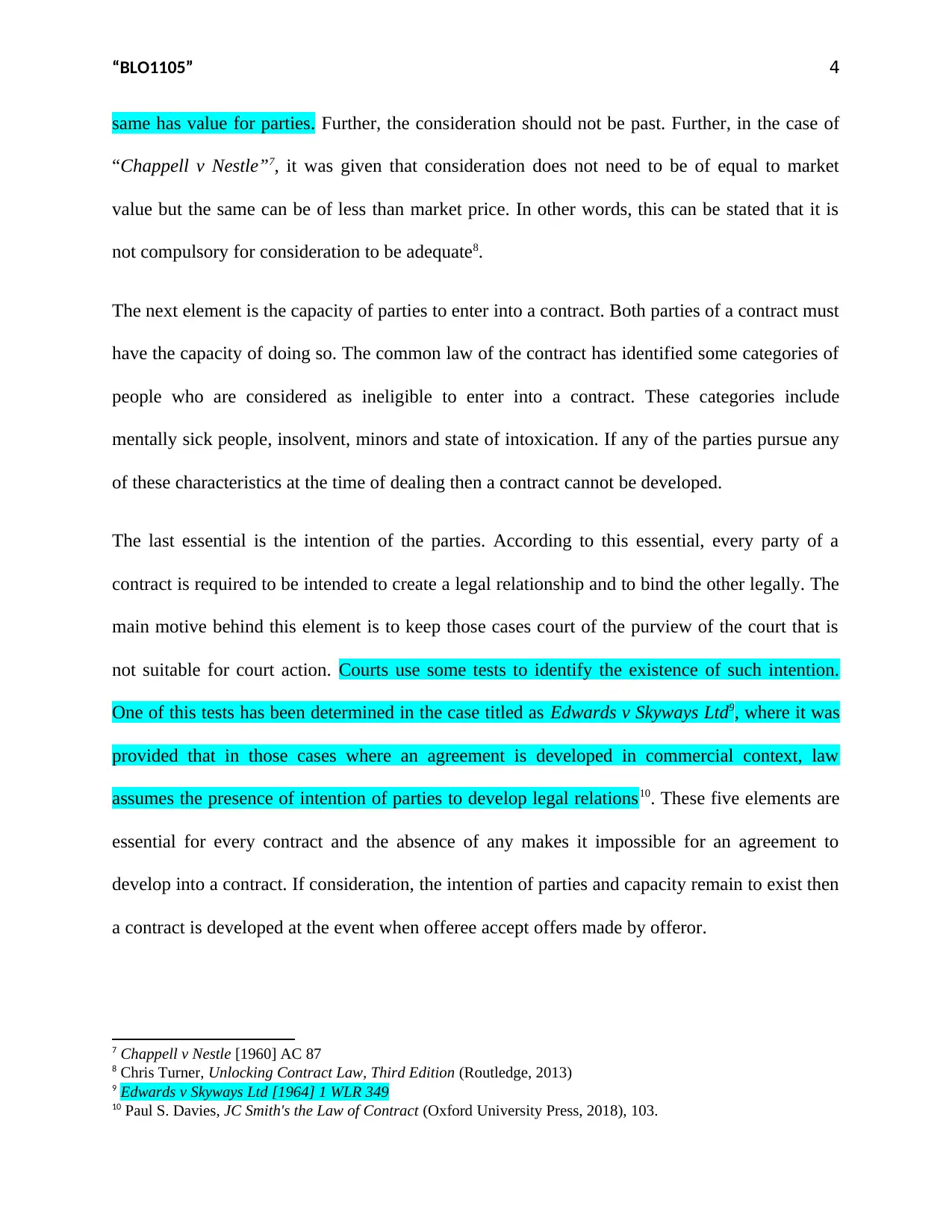
“BLO1105” 4
same has value for parties. Further, the consideration should not be past. Further, in the case of
“Chappell v Nestle”7, it was given that consideration does not need to be of equal to market
value but the same can be of less than market price. In other words, this can be stated that it is
not compulsory for consideration to be adequate8.
The next element is the capacity of parties to enter into a contract. Both parties of a contract must
have the capacity of doing so. The common law of the contract has identified some categories of
people who are considered as ineligible to enter into a contract. These categories include
mentally sick people, insolvent, minors and state of intoxication. If any of the parties pursue any
of these characteristics at the time of dealing then a contract cannot be developed.
The last essential is the intention of the parties. According to this essential, every party of a
contract is required to be intended to create a legal relationship and to bind the other legally. The
main motive behind this element is to keep those cases court of the purview of the court that is
not suitable for court action. Courts use some tests to identify the existence of such intention.
One of this tests has been determined in the case titled as Edwards v Skyways Ltd9, where it was
provided that in those cases where an agreement is developed in commercial context, law
assumes the presence of intention of parties to develop legal relations10. These five elements are
essential for every contract and the absence of any makes it impossible for an agreement to
develop into a contract. If consideration, the intention of parties and capacity remain to exist then
a contract is developed at the event when offeree accept offers made by offeror.
7 Chappell v Nestle [1960] AC 87
8 Chris Turner, Unlocking Contract Law, Third Edition (Routledge, 2013)
9 Edwards v Skyways Ltd [1964] 1 WLR 349
10 Paul S. Davies, JC Smith's the Law of Contract (Oxford University Press, 2018), 103.
same has value for parties. Further, the consideration should not be past. Further, in the case of
“Chappell v Nestle”7, it was given that consideration does not need to be of equal to market
value but the same can be of less than market price. In other words, this can be stated that it is
not compulsory for consideration to be adequate8.
The next element is the capacity of parties to enter into a contract. Both parties of a contract must
have the capacity of doing so. The common law of the contract has identified some categories of
people who are considered as ineligible to enter into a contract. These categories include
mentally sick people, insolvent, minors and state of intoxication. If any of the parties pursue any
of these characteristics at the time of dealing then a contract cannot be developed.
The last essential is the intention of the parties. According to this essential, every party of a
contract is required to be intended to create a legal relationship and to bind the other legally. The
main motive behind this element is to keep those cases court of the purview of the court that is
not suitable for court action. Courts use some tests to identify the existence of such intention.
One of this tests has been determined in the case titled as Edwards v Skyways Ltd9, where it was
provided that in those cases where an agreement is developed in commercial context, law
assumes the presence of intention of parties to develop legal relations10. These five elements are
essential for every contract and the absence of any makes it impossible for an agreement to
develop into a contract. If consideration, the intention of parties and capacity remain to exist then
a contract is developed at the event when offeree accept offers made by offeror.
7 Chappell v Nestle [1960] AC 87
8 Chris Turner, Unlocking Contract Law, Third Edition (Routledge, 2013)
9 Edwards v Skyways Ltd [1964] 1 WLR 349
10 Paul S. Davies, JC Smith's the Law of Contract (Oxford University Press, 2018), 103.
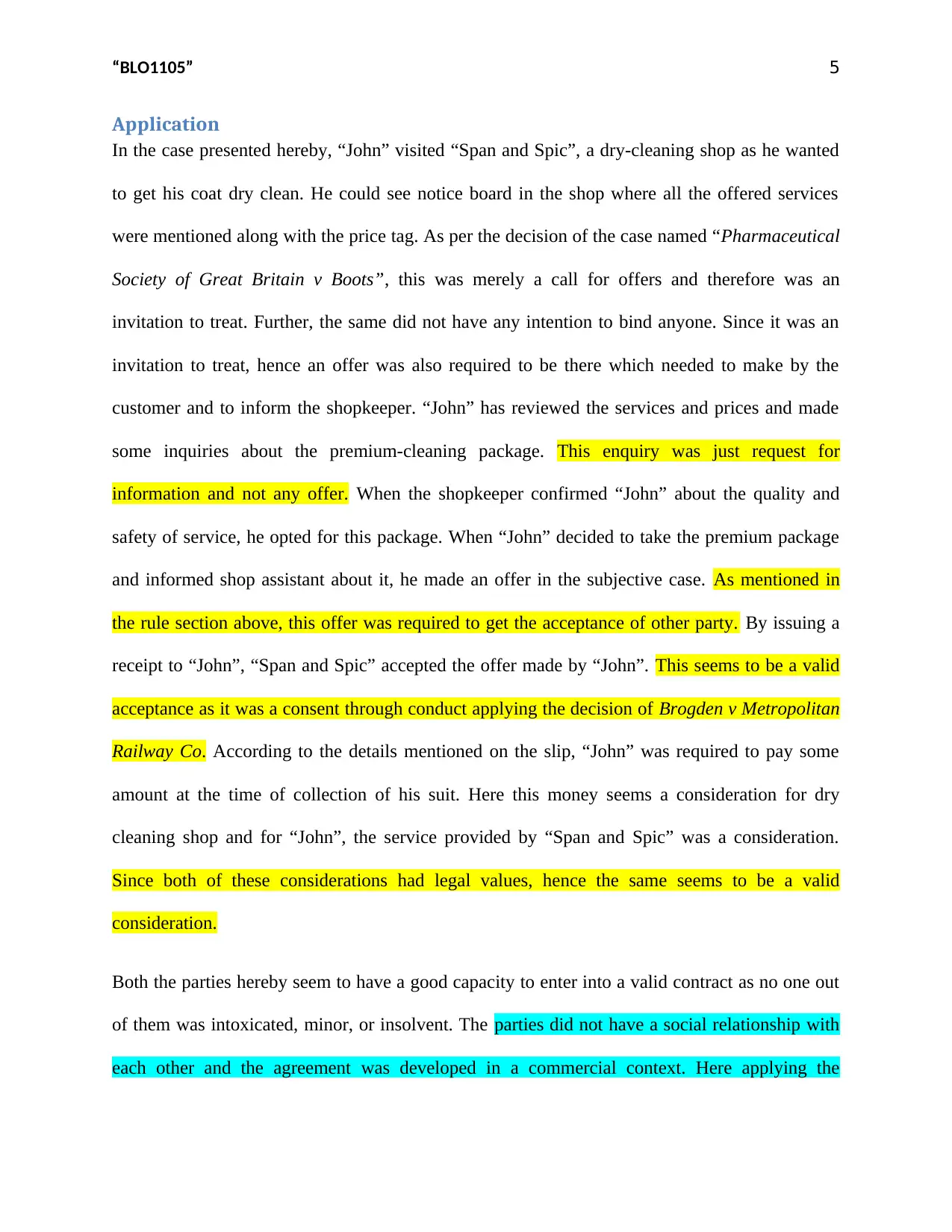
“BLO1105” 5
Application
In the case presented hereby, “John” visited “Span and Spic”, a dry-cleaning shop as he wanted
to get his coat dry clean. He could see notice board in the shop where all the offered services
were mentioned along with the price tag. As per the decision of the case named “Pharmaceutical
Society of Great Britain v Boots”, this was merely a call for offers and therefore was an
invitation to treat. Further, the same did not have any intention to bind anyone. Since it was an
invitation to treat, hence an offer was also required to be there which needed to make by the
customer and to inform the shopkeeper. “John” has reviewed the services and prices and made
some inquiries about the premium-cleaning package. This enquiry was just request for
information and not any offer. When the shopkeeper confirmed “John” about the quality and
safety of service, he opted for this package. When “John” decided to take the premium package
and informed shop assistant about it, he made an offer in the subjective case. As mentioned in
the rule section above, this offer was required to get the acceptance of other party. By issuing a
receipt to “John”, “Span and Spic” accepted the offer made by “John”. This seems to be a valid
acceptance as it was a consent through conduct applying the decision of Brogden v Metropolitan
Railway Co. According to the details mentioned on the slip, “John” was required to pay some
amount at the time of collection of his suit. Here this money seems a consideration for dry
cleaning shop and for “John”, the service provided by “Span and Spic” was a consideration.
Since both of these considerations had legal values, hence the same seems to be a valid
consideration.
Both the parties hereby seem to have a good capacity to enter into a valid contract as no one out
of them was intoxicated, minor, or insolvent. The parties did not have a social relationship with
each other and the agreement was developed in a commercial context. Here applying the
Application
In the case presented hereby, “John” visited “Span and Spic”, a dry-cleaning shop as he wanted
to get his coat dry clean. He could see notice board in the shop where all the offered services
were mentioned along with the price tag. As per the decision of the case named “Pharmaceutical
Society of Great Britain v Boots”, this was merely a call for offers and therefore was an
invitation to treat. Further, the same did not have any intention to bind anyone. Since it was an
invitation to treat, hence an offer was also required to be there which needed to make by the
customer and to inform the shopkeeper. “John” has reviewed the services and prices and made
some inquiries about the premium-cleaning package. This enquiry was just request for
information and not any offer. When the shopkeeper confirmed “John” about the quality and
safety of service, he opted for this package. When “John” decided to take the premium package
and informed shop assistant about it, he made an offer in the subjective case. As mentioned in
the rule section above, this offer was required to get the acceptance of other party. By issuing a
receipt to “John”, “Span and Spic” accepted the offer made by “John”. This seems to be a valid
acceptance as it was a consent through conduct applying the decision of Brogden v Metropolitan
Railway Co. According to the details mentioned on the slip, “John” was required to pay some
amount at the time of collection of his suit. Here this money seems a consideration for dry
cleaning shop and for “John”, the service provided by “Span and Spic” was a consideration.
Since both of these considerations had legal values, hence the same seems to be a valid
consideration.
Both the parties hereby seem to have a good capacity to enter into a valid contract as no one out
of them was intoxicated, minor, or insolvent. The parties did not have a social relationship with
each other and the agreement was developed in a commercial context. Here applying the
⊘ This is a preview!⊘
Do you want full access?
Subscribe today to unlock all pages.

Trusted by 1+ million students worldwide
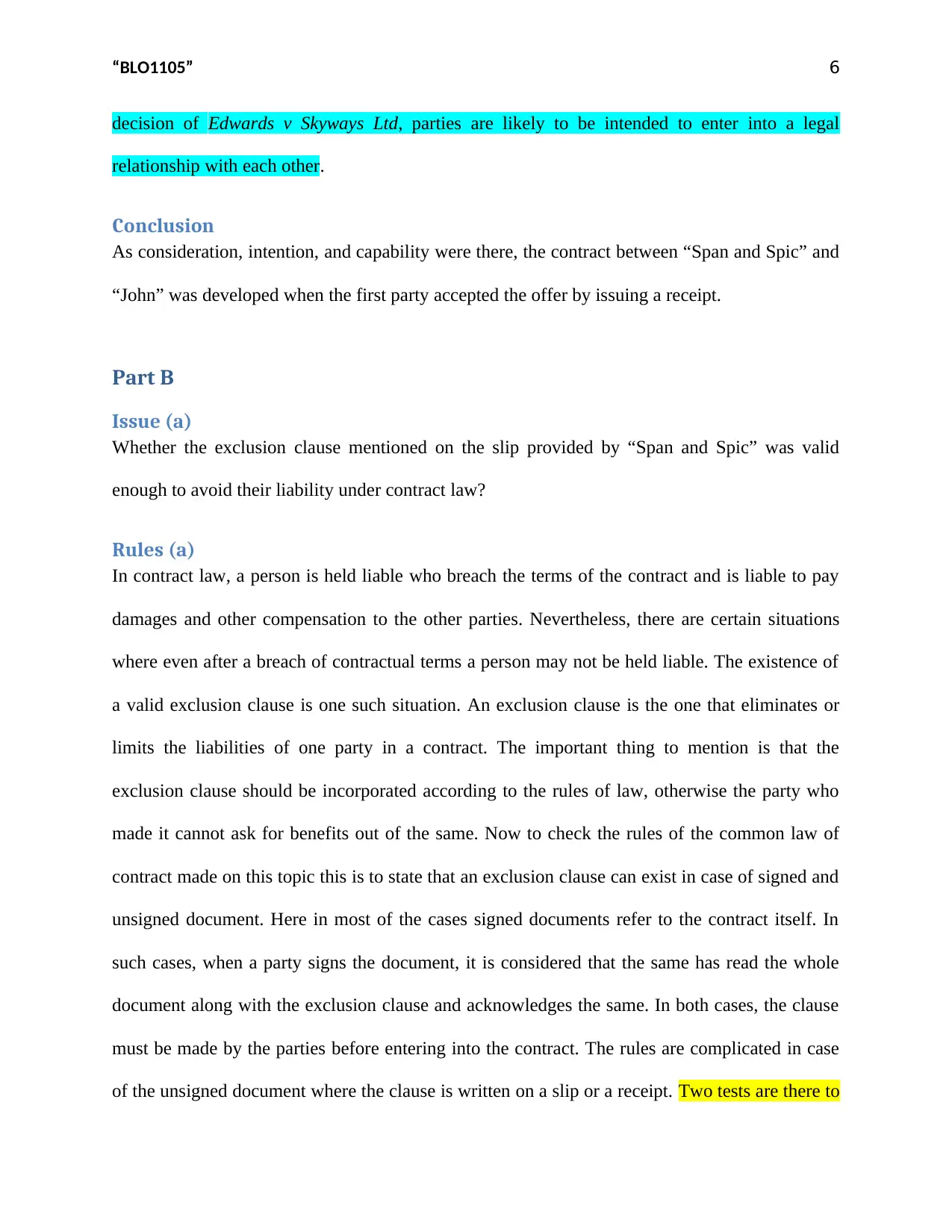
“BLO1105” 6
decision of Edwards v Skyways Ltd, parties are likely to be intended to enter into a legal
relationship with each other.
Conclusion
As consideration, intention, and capability were there, the contract between “Span and Spic” and
“John” was developed when the first party accepted the offer by issuing a receipt.
Part B
Issue (a)
Whether the exclusion clause mentioned on the slip provided by “Span and Spic” was valid
enough to avoid their liability under contract law?
Rules (a)
In contract law, a person is held liable who breach the terms of the contract and is liable to pay
damages and other compensation to the other parties. Nevertheless, there are certain situations
where even after a breach of contractual terms a person may not be held liable. The existence of
a valid exclusion clause is one such situation. An exclusion clause is the one that eliminates or
limits the liabilities of one party in a contract. The important thing to mention is that the
exclusion clause should be incorporated according to the rules of law, otherwise the party who
made it cannot ask for benefits out of the same. Now to check the rules of the common law of
contract made on this topic this is to state that an exclusion clause can exist in case of signed and
unsigned document. Here in most of the cases signed documents refer to the contract itself. In
such cases, when a party signs the document, it is considered that the same has read the whole
document along with the exclusion clause and acknowledges the same. In both cases, the clause
must be made by the parties before entering into the contract. The rules are complicated in case
of the unsigned document where the clause is written on a slip or a receipt. Two tests are there to
decision of Edwards v Skyways Ltd, parties are likely to be intended to enter into a legal
relationship with each other.
Conclusion
As consideration, intention, and capability were there, the contract between “Span and Spic” and
“John” was developed when the first party accepted the offer by issuing a receipt.
Part B
Issue (a)
Whether the exclusion clause mentioned on the slip provided by “Span and Spic” was valid
enough to avoid their liability under contract law?
Rules (a)
In contract law, a person is held liable who breach the terms of the contract and is liable to pay
damages and other compensation to the other parties. Nevertheless, there are certain situations
where even after a breach of contractual terms a person may not be held liable. The existence of
a valid exclusion clause is one such situation. An exclusion clause is the one that eliminates or
limits the liabilities of one party in a contract. The important thing to mention is that the
exclusion clause should be incorporated according to the rules of law, otherwise the party who
made it cannot ask for benefits out of the same. Now to check the rules of the common law of
contract made on this topic this is to state that an exclusion clause can exist in case of signed and
unsigned document. Here in most of the cases signed documents refer to the contract itself. In
such cases, when a party signs the document, it is considered that the same has read the whole
document along with the exclusion clause and acknowledges the same. In both cases, the clause
must be made by the parties before entering into the contract. The rules are complicated in case
of the unsigned document where the clause is written on a slip or a receipt. Two tests are there to
Paraphrase This Document
Need a fresh take? Get an instant paraphrase of this document with our AI Paraphraser
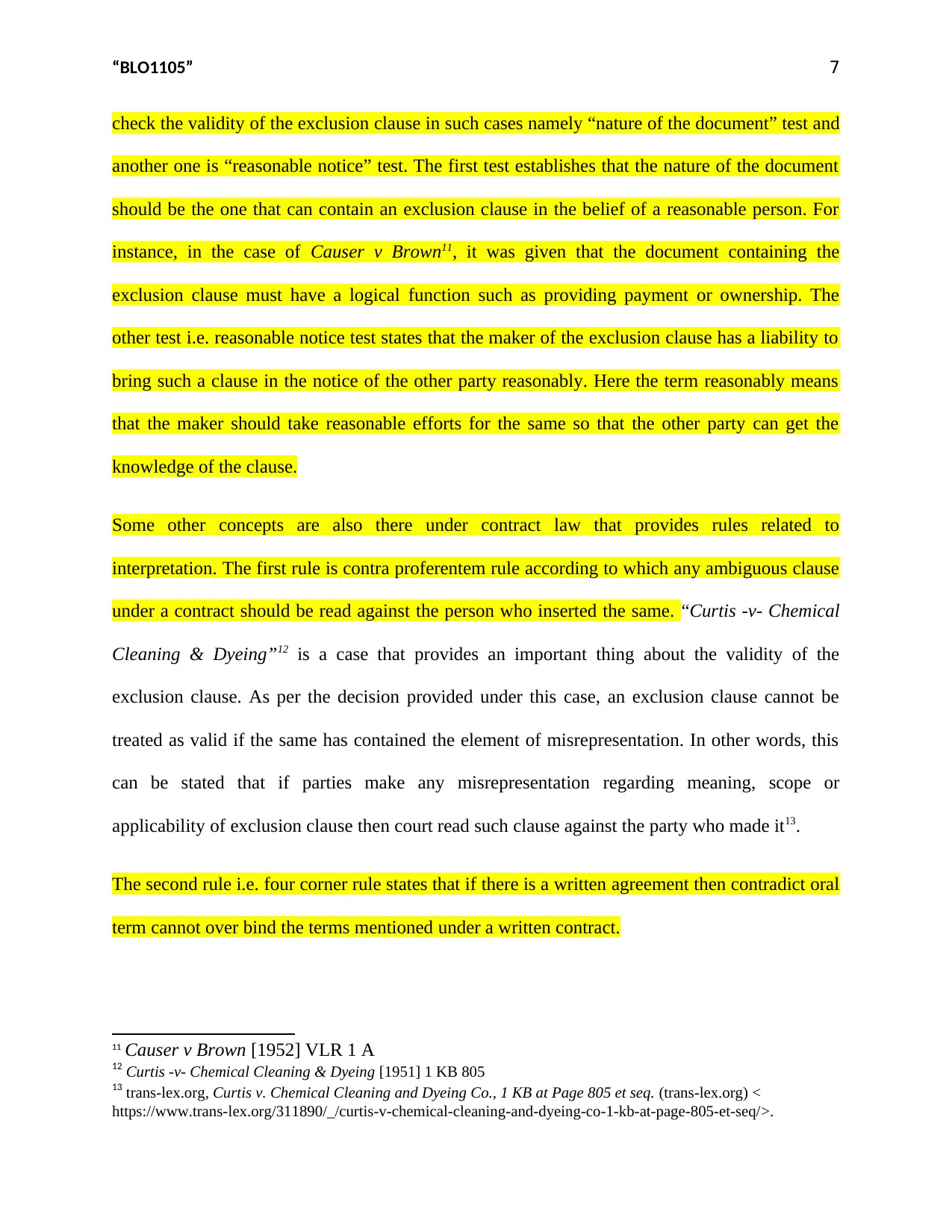
“BLO1105” 7
check the validity of the exclusion clause in such cases namely “nature of the document” test and
another one is “reasonable notice” test. The first test establishes that the nature of the document
should be the one that can contain an exclusion clause in the belief of a reasonable person. For
instance, in the case of Causer v Brown11, it was given that the document containing the
exclusion clause must have a logical function such as providing payment or ownership. The
other test i.e. reasonable notice test states that the maker of the exclusion clause has a liability to
bring such a clause in the notice of the other party reasonably. Here the term reasonably means
that the maker should take reasonable efforts for the same so that the other party can get the
knowledge of the clause.
Some other concepts are also there under contract law that provides rules related to
interpretation. The first rule is contra proferentem rule according to which any ambiguous clause
under a contract should be read against the person who inserted the same. “Curtis -v- Chemical
Cleaning & Dyeing”12 is a case that provides an important thing about the validity of the
exclusion clause. As per the decision provided under this case, an exclusion clause cannot be
treated as valid if the same has contained the element of misrepresentation. In other words, this
can be stated that if parties make any misrepresentation regarding meaning, scope or
applicability of exclusion clause then court read such clause against the party who made it13.
The second rule i.e. four corner rule states that if there is a written agreement then contradict oral
term cannot over bind the terms mentioned under a written contract.
11 Causer v Brown [1952] VLR 1 A
12 Curtis -v- Chemical Cleaning & Dyeing [1951] 1 KB 805
13 trans-lex.org, Curtis v. Chemical Cleaning and Dyeing Co., 1 KB at Page 805 et seq. (trans-lex.org) <
https://www.trans-lex.org/311890/_/curtis-v-chemical-cleaning-and-dyeing-co-1-kb-at-page-805-et-seq/>.
check the validity of the exclusion clause in such cases namely “nature of the document” test and
another one is “reasonable notice” test. The first test establishes that the nature of the document
should be the one that can contain an exclusion clause in the belief of a reasonable person. For
instance, in the case of Causer v Brown11, it was given that the document containing the
exclusion clause must have a logical function such as providing payment or ownership. The
other test i.e. reasonable notice test states that the maker of the exclusion clause has a liability to
bring such a clause in the notice of the other party reasonably. Here the term reasonably means
that the maker should take reasonable efforts for the same so that the other party can get the
knowledge of the clause.
Some other concepts are also there under contract law that provides rules related to
interpretation. The first rule is contra proferentem rule according to which any ambiguous clause
under a contract should be read against the person who inserted the same. “Curtis -v- Chemical
Cleaning & Dyeing”12 is a case that provides an important thing about the validity of the
exclusion clause. As per the decision provided under this case, an exclusion clause cannot be
treated as valid if the same has contained the element of misrepresentation. In other words, this
can be stated that if parties make any misrepresentation regarding meaning, scope or
applicability of exclusion clause then court read such clause against the party who made it13.
The second rule i.e. four corner rule states that if there is a written agreement then contradict oral
term cannot over bind the terms mentioned under a written contract.
11 Causer v Brown [1952] VLR 1 A
12 Curtis -v- Chemical Cleaning & Dyeing [1951] 1 KB 805
13 trans-lex.org, Curtis v. Chemical Cleaning and Dyeing Co., 1 KB at Page 805 et seq. (trans-lex.org) <
https://www.trans-lex.org/311890/_/curtis-v-chemical-cleaning-and-dyeing-co-1-kb-at-page-805-et-seq/>.

“BLO1105” 8
Application (a)
In the case provided hereby, the exclusion clause was placed on the backside of the slip issued by
“Span and Spic” to “John”. The issue of the case started when after taking delivery of the court,
“John” noticed some damages on one of the sides of his court. As the receipt contained an
exclusion clause in this case hence the provisions related to unsigned documents are likely to be
applicable. Considering the first test i.e. “the nature of the document test” the clause seems to be
held valid.
Considering rules of law related to the legitimacy of an exclusion clause, this is to state that
“John” has received the receipt along with the acceptance of the contract whereas the clause was
required to be inserted earlier of it. The shop owner did not make any efforts to bring the clause
into the notice of John and hence this test did not successfully apply in the given scenario.
Further, when “John” asked about the safety of services he has been assured that no damages
would be held to his coat, whereas the exclusion clause excluded liability for damages. In this
manner, the exclusion clause was different from what has been represented to the “John” by the
sales executive of the shop. Here, the four-corner rule cannot be applicable due to the absence of
a written contract. Applying the decision of “Curtis -v- Chemical Cleaning & Dyeing”, the
clause should be read against “Span and Spic” rather than “John”.
Conclusion (a)
The subjective exclusion clause does not seem to be valid and therefore shall not limit the
liability of “Span and Spic”.
Issue (b)
Whether the exclusion clause mentioned on the slip provided by “Span and Spic” was valid
enough to avoid their liability under Consumer Law?
Application (a)
In the case provided hereby, the exclusion clause was placed on the backside of the slip issued by
“Span and Spic” to “John”. The issue of the case started when after taking delivery of the court,
“John” noticed some damages on one of the sides of his court. As the receipt contained an
exclusion clause in this case hence the provisions related to unsigned documents are likely to be
applicable. Considering the first test i.e. “the nature of the document test” the clause seems to be
held valid.
Considering rules of law related to the legitimacy of an exclusion clause, this is to state that
“John” has received the receipt along with the acceptance of the contract whereas the clause was
required to be inserted earlier of it. The shop owner did not make any efforts to bring the clause
into the notice of John and hence this test did not successfully apply in the given scenario.
Further, when “John” asked about the safety of services he has been assured that no damages
would be held to his coat, whereas the exclusion clause excluded liability for damages. In this
manner, the exclusion clause was different from what has been represented to the “John” by the
sales executive of the shop. Here, the four-corner rule cannot be applicable due to the absence of
a written contract. Applying the decision of “Curtis -v- Chemical Cleaning & Dyeing”, the
clause should be read against “Span and Spic” rather than “John”.
Conclusion (a)
The subjective exclusion clause does not seem to be valid and therefore shall not limit the
liability of “Span and Spic”.
Issue (b)
Whether the exclusion clause mentioned on the slip provided by “Span and Spic” was valid
enough to avoid their liability under Consumer Law?
⊘ This is a preview!⊘
Do you want full access?
Subscribe today to unlock all pages.

Trusted by 1+ million students worldwide
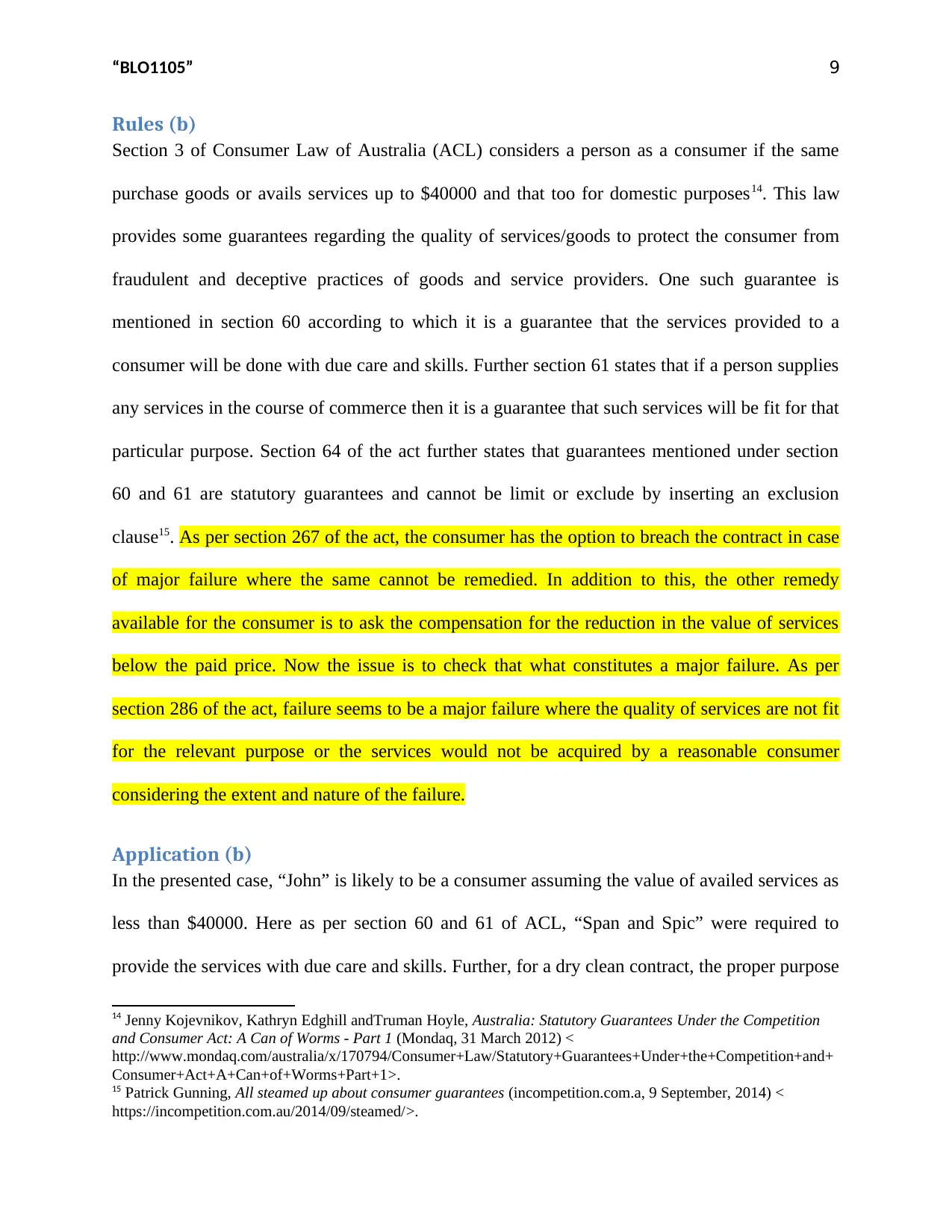
“BLO1105” 9
Rules (b)
Section 3 of Consumer Law of Australia (ACL) considers a person as a consumer if the same
purchase goods or avails services up to $40000 and that too for domestic purposes14. This law
provides some guarantees regarding the quality of services/goods to protect the consumer from
fraudulent and deceptive practices of goods and service providers. One such guarantee is
mentioned in section 60 according to which it is a guarantee that the services provided to a
consumer will be done with due care and skills. Further section 61 states that if a person supplies
any services in the course of commerce then it is a guarantee that such services will be fit for that
particular purpose. Section 64 of the act further states that guarantees mentioned under section
60 and 61 are statutory guarantees and cannot be limit or exclude by inserting an exclusion
clause15. As per section 267 of the act, the consumer has the option to breach the contract in case
of major failure where the same cannot be remedied. In addition to this, the other remedy
available for the consumer is to ask the compensation for the reduction in the value of services
below the paid price. Now the issue is to check that what constitutes a major failure. As per
section 286 of the act, failure seems to be a major failure where the quality of services are not fit
for the relevant purpose or the services would not be acquired by a reasonable consumer
considering the extent and nature of the failure.
Application (b)
In the presented case, “John” is likely to be a consumer assuming the value of availed services as
less than $40000. Here as per section 60 and 61 of ACL, “Span and Spic” were required to
provide the services with due care and skills. Further, for a dry clean contract, the proper purpose
14 Jenny Kojevnikov, Kathryn Edghill andTruman Hoyle, Australia: Statutory Guarantees Under the Competition
and Consumer Act: A Can of Worms - Part 1 (Mondaq, 31 March 2012) <
http://www.mondaq.com/australia/x/170794/Consumer+Law/Statutory+Guarantees+Under+the+Competition+and+
Consumer+Act+A+Can+of+Worms+Part+1>.
15 Patrick Gunning, All steamed up about consumer guarantees (incompetition.com.a, 9 September, 2014) <
https://incompetition.com.au/2014/09/steamed/>.
Rules (b)
Section 3 of Consumer Law of Australia (ACL) considers a person as a consumer if the same
purchase goods or avails services up to $40000 and that too for domestic purposes14. This law
provides some guarantees regarding the quality of services/goods to protect the consumer from
fraudulent and deceptive practices of goods and service providers. One such guarantee is
mentioned in section 60 according to which it is a guarantee that the services provided to a
consumer will be done with due care and skills. Further section 61 states that if a person supplies
any services in the course of commerce then it is a guarantee that such services will be fit for that
particular purpose. Section 64 of the act further states that guarantees mentioned under section
60 and 61 are statutory guarantees and cannot be limit or exclude by inserting an exclusion
clause15. As per section 267 of the act, the consumer has the option to breach the contract in case
of major failure where the same cannot be remedied. In addition to this, the other remedy
available for the consumer is to ask the compensation for the reduction in the value of services
below the paid price. Now the issue is to check that what constitutes a major failure. As per
section 286 of the act, failure seems to be a major failure where the quality of services are not fit
for the relevant purpose or the services would not be acquired by a reasonable consumer
considering the extent and nature of the failure.
Application (b)
In the presented case, “John” is likely to be a consumer assuming the value of availed services as
less than $40000. Here as per section 60 and 61 of ACL, “Span and Spic” were required to
provide the services with due care and skills. Further, for a dry clean contract, the proper purpose
14 Jenny Kojevnikov, Kathryn Edghill andTruman Hoyle, Australia: Statutory Guarantees Under the Competition
and Consumer Act: A Can of Worms - Part 1 (Mondaq, 31 March 2012) <
http://www.mondaq.com/australia/x/170794/Consumer+Law/Statutory+Guarantees+Under+the+Competition+and+
Consumer+Act+A+Can+of+Worms+Part+1>.
15 Patrick Gunning, All steamed up about consumer guarantees (incompetition.com.a, 9 September, 2014) <
https://incompetition.com.au/2014/09/steamed/>.
Paraphrase This Document
Need a fresh take? Get an instant paraphrase of this document with our AI Paraphraser
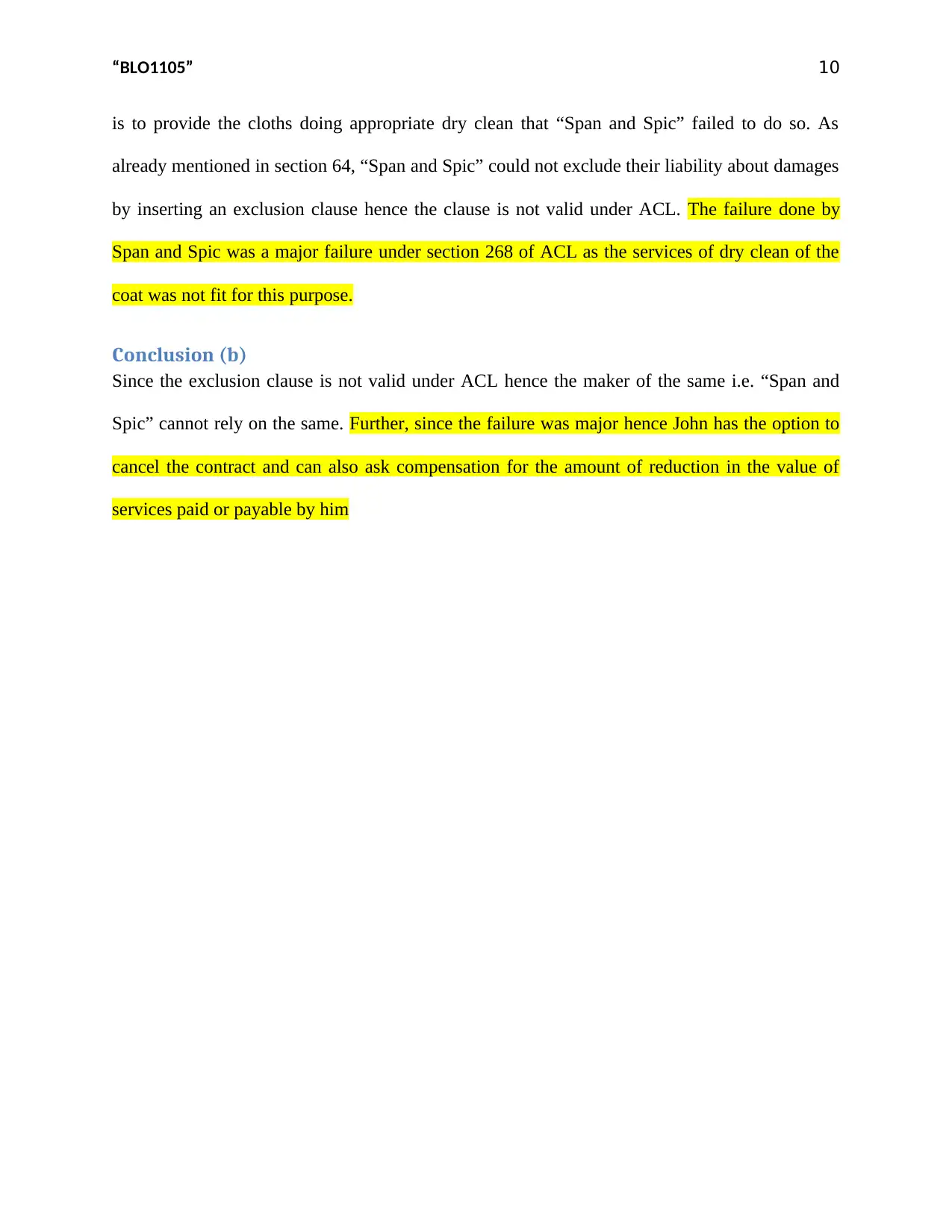
“BLO1105” 10
is to provide the cloths doing appropriate dry clean that “Span and Spic” failed to do so. As
already mentioned in section 64, “Span and Spic” could not exclude their liability about damages
by inserting an exclusion clause hence the clause is not valid under ACL. The failure done by
Span and Spic was a major failure under section 268 of ACL as the services of dry clean of the
coat was not fit for this purpose.
Conclusion (b)
Since the exclusion clause is not valid under ACL hence the maker of the same i.e. “Span and
Spic” cannot rely on the same. Further, since the failure was major hence John has the option to
cancel the contract and can also ask compensation for the amount of reduction in the value of
services paid or payable by him
is to provide the cloths doing appropriate dry clean that “Span and Spic” failed to do so. As
already mentioned in section 64, “Span and Spic” could not exclude their liability about damages
by inserting an exclusion clause hence the clause is not valid under ACL. The failure done by
Span and Spic was a major failure under section 268 of ACL as the services of dry clean of the
coat was not fit for this purpose.
Conclusion (b)
Since the exclusion clause is not valid under ACL hence the maker of the same i.e. “Span and
Spic” cannot rely on the same. Further, since the failure was major hence John has the option to
cancel the contract and can also ask compensation for the amount of reduction in the value of
services paid or payable by him
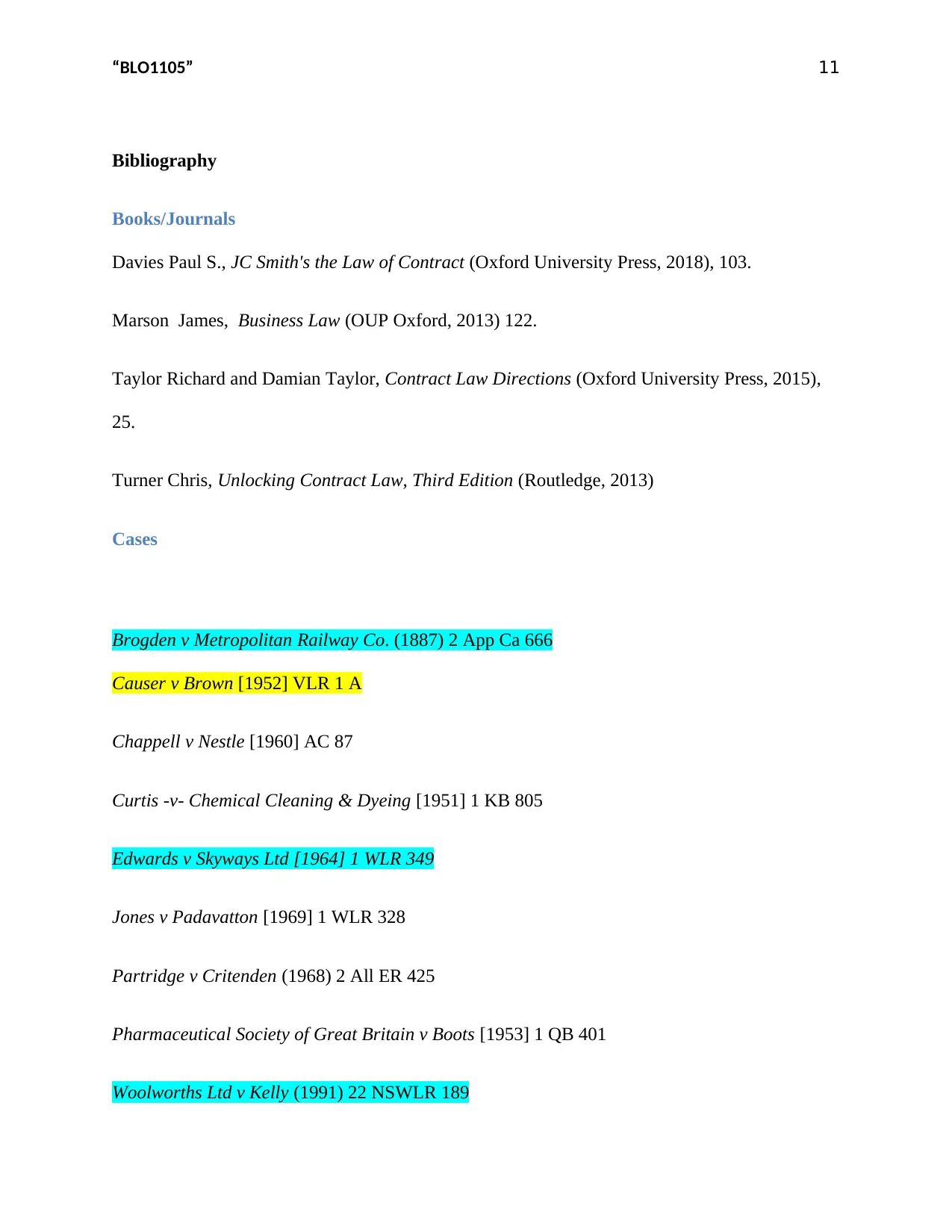
“BLO1105” 11
Bibliography
Books/Journals
Davies Paul S., JC Smith's the Law of Contract (Oxford University Press, 2018), 103.
Marson James, Business Law (OUP Oxford, 2013) 122.
Taylor Richard and Damian Taylor, Contract Law Directions (Oxford University Press, 2015),
25.
Turner Chris, Unlocking Contract Law, Third Edition (Routledge, 2013)
Cases
Brogden v Metropolitan Railway Co. (1887) 2 App Ca 666
Causer v Brown [1952] VLR 1 A
Chappell v Nestle [1960] AC 87
Curtis -v- Chemical Cleaning & Dyeing [1951] 1 KB 805
Edwards v Skyways Ltd [1964] 1 WLR 349
Jones v Padavatton [1969] 1 WLR 328
Partridge v Critenden (1968) 2 All ER 425
Pharmaceutical Society of Great Britain v Boots [1953] 1 QB 401
Woolworths Ltd v Kelly (1991) 22 NSWLR 189
Bibliography
Books/Journals
Davies Paul S., JC Smith's the Law of Contract (Oxford University Press, 2018), 103.
Marson James, Business Law (OUP Oxford, 2013) 122.
Taylor Richard and Damian Taylor, Contract Law Directions (Oxford University Press, 2015),
25.
Turner Chris, Unlocking Contract Law, Third Edition (Routledge, 2013)
Cases
Brogden v Metropolitan Railway Co. (1887) 2 App Ca 666
Causer v Brown [1952] VLR 1 A
Chappell v Nestle [1960] AC 87
Curtis -v- Chemical Cleaning & Dyeing [1951] 1 KB 805
Edwards v Skyways Ltd [1964] 1 WLR 349
Jones v Padavatton [1969] 1 WLR 328
Partridge v Critenden (1968) 2 All ER 425
Pharmaceutical Society of Great Britain v Boots [1953] 1 QB 401
Woolworths Ltd v Kelly (1991) 22 NSWLR 189
⊘ This is a preview!⊘
Do you want full access?
Subscribe today to unlock all pages.

Trusted by 1+ million students worldwide
1 out of 13
Related Documents
Your All-in-One AI-Powered Toolkit for Academic Success.
+13062052269
info@desklib.com
Available 24*7 on WhatsApp / Email
![[object Object]](/_next/static/media/star-bottom.7253800d.svg)
Unlock your academic potential
Copyright © 2020–2025 A2Z Services. All Rights Reserved. Developed and managed by ZUCOL.





